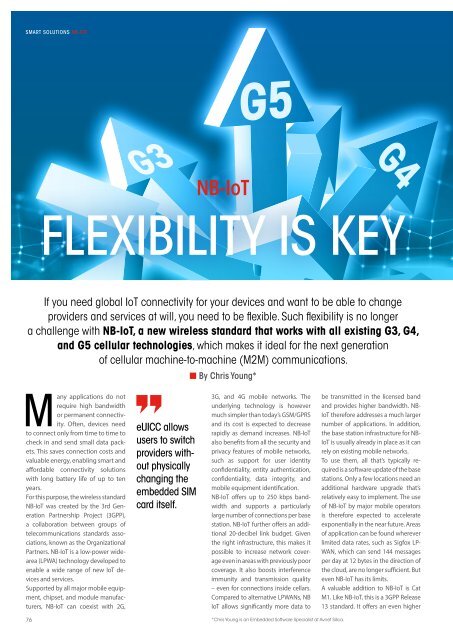Smart Industry 2/2018
Smart Industry 2/2018 - The IoT Business Magazine - powered by Avnet Silica
Smart Industry 2/2018 - The IoT Business Magazine - powered by Avnet Silica
You also want an ePaper? Increase the reach of your titles
YUMPU automatically turns print PDFs into web optimized ePapers that Google loves.
<strong>Smart</strong> Solutions NB-IoT<br />
G5<br />
G3<br />
NB-IoT<br />
G4<br />
Flexibility is key<br />
If you need global IoT connectivity for your devices and want to be able to change<br />
providers and services at will, you need to be flexible. Such flexibility is no longer<br />
a challenge with NB-IoT, a new wireless standard that works with all existing G3, G4,<br />
and G5 cellular technologies, which makes it ideal for the next generation<br />
of cellular machine-to-machine (M2M) communications.<br />
n By Chris Young*<br />
Many applications do not<br />
require high bandwidth<br />
or permanent connectivity.<br />
Often, devices need<br />
to connect only from time to time to<br />
check in and send small data packets.<br />
This saves connection costs and<br />
valuable energy, enabling smart and<br />
affordable connectivity solutions<br />
with long battery life of up to ten<br />
years.<br />
For this purpose, the wireless standard<br />
NB-IoT was created by the 3rd Generation<br />
Partnership Project (3GPP),<br />
a collaboration between groups of<br />
telecommunications standards associations,<br />
known as the Organizational<br />
Partners. NB-IoT is a low-power widearea<br />
(LPWA) technology developed to<br />
enable a wide range of new IoT devices<br />
and services.<br />
Supported by all major mobile equipment,<br />
chipset, and module manufacturers,<br />
NB-IoT can coexist with 2G,<br />
eUICC allows<br />
users to switch<br />
providers without<br />
physically<br />
changing the<br />
embedded SIM<br />
card itself.<br />
3G, and 4G mobile networks. The<br />
underlying technology is however<br />
much simpler than today’s GSM/GPRS<br />
and its cost is expected to decrease<br />
rapidly as demand increases. NB-IoT<br />
also benefits from all the security and<br />
privacy features of mobile networks,<br />
such as support for user identity<br />
confidentiality, entity authentication,<br />
confidentiality, data integrity, and<br />
mobile equipment identification.<br />
NB-IoT offers up to 250 kbps bandwidth<br />
and supports a particularly<br />
large number of connections per base<br />
station. NB-IoT further offers an additional<br />
20-decibel link budget. Given<br />
the right infrastructure, this makes it<br />
possible to increase network coverage<br />
even in areas with previously poor<br />
coverage. It also boosts interference<br />
immunity and transmission quality<br />
– even for connections inside cellars.<br />
Compared to alternative LPWANs, NB<br />
IoT allows significantly more data to<br />
be transmitted in the licensed band<br />
and provides higher bandwidth. NB-<br />
IoT therefore addresses a much larger<br />
number of applications. In addition,<br />
the base station infrastructure for NB-<br />
IoT is usually already in place as it can<br />
rely on existing mobile networks.<br />
To use them, all that’s typically required<br />
is a software update of the base<br />
stations. Only a few locations need an<br />
additional hardware upgrade that’s<br />
relatively easy to implement. The use<br />
of NB-IoT by major mobile operators<br />
is therefore expected to accelerate<br />
exponentially in the near future. Areas<br />
of application can be found wherever<br />
limited data rates, such as Sigfox LP-<br />
WAN, which can send 144 messages<br />
per day at 12 bytes in the direction of<br />
the cloud, are no longer sufficient. But<br />
even NB-IoT has its limits.<br />
A valuable addition to NB-IoT is Cat<br />
M1. Like NB-IoT, this is a 3GPP Release<br />
13 standard. It offers an even higher<br />
76<br />
*Chris Young is an Embedded Software Specialist at Avnet Silica.
















